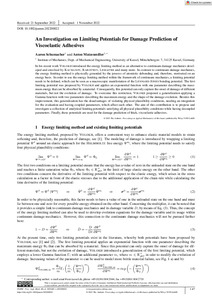| dc.date.accessioned | 2023-04-19T12:38:24Z | |
| dc.date.available | 2023-04-19T12:38:24Z | |
| dc.date.issued | 2023-03-24 | |
| dc.identifier | doi:10.17170/kobra-202304197841 | |
| dc.identifier.uri | http://hdl.handle.net/123456789/14600 | |
| dc.description.sponsorship | Gefördert im Rahmen des Projekts DEAL | ger |
| dc.language.iso | eng | |
| dc.rights | Attribution-NonCommercial-NoDerivatives 4.0 International | * |
| dc.rights.uri | http://creativecommons.org/licenses/by-nc-nd/4.0/ | * |
| dc.subject.ddc | 510 | |
| dc.subject.ddc | 620 | |
| dc.title | An Investigation on Limiting Potentials for Damage Prediction of Viscoelastic Adhesives | eng |
| dc.type | Aufsatz | |
| dcterms.abstract | In his recent work VOLOKH introduced the energy limiting method as an alternative to continuum damage mechanics developed and envolved by KACHANOV, RABOTNOV, LEMAITRE and many more. In contrast to continuum damage mechanics, the energy limiting method is physically grounded by the process of atomistic debonding and, therefore, motivated on an energy basis. In order to use the energy limiting method within the framework of continuum mechanics, a limiting potential needs to be defined, which can be seen as a macroscopic manifestation of the LENNARD-JONES bonding potential. The first limiting potential was proposed by VOLOKH and applies an exponential function with one parameter describing the maximum energy that can be absorbed by a material. Consequently, this potential can only capture the onset of damage of different materials, but not the evolution of damage. To overcome this restriction, VOLOKH proposed a generalization applying a Gamma function with two parameters describing the maximum energy and the shape of the damage evolution. Besides this improvement, this generalization has the disadvantages of violating physical plausibility conditions, needing an integration for the evaluation and having coupled parameters, which affect each other. The aim of this contribution is to propose and investigate a collection of analytical limiting potentials satisfying all physical plausibility conditions while having decoupled parameters. Finally, these potentials are used for the damage prediction of thick, viscoelastic adhesives. | eng |
| dcterms.accessRights | open access | |
| dcterms.creator | Schumacher, Aaron | |
| dcterms.creator | Matzenmiller, Anton | |
| dcterms.extent | 7 Seiten | |
| dc.relation.doi | doi:10.1002/pamm.202200022 | |
| dc.subject.swd | Schadensmechanik | ger |
| dc.subject.swd | Klebstoff | ger |
| dc.subject.swd | Kontinuumsmechanik | ger |
| dc.subject.swd | Viskoelastizität | ger |
| dc.type.version | publishedVersion | |
| dcterms.source.identifier | eissn:1617-7061 | |
| dcterms.source.issue | Issue 1 | |
| dcterms.source.journal | Proceedings in applied mathematics and mechanics : PAMM | eng |
| dcterms.source.volume | Volume 22 | |
| kup.iskup | false | |
| dcterms.source.articlenumber | e202200022 | |


